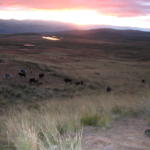


The Mountain Institute
Canrey grande, CC Canrey Chico, CC Los Andes, UNASAM
Bolivia
11/2015—11/2018
Because of the low night temperatures in the Andean region, decomposition processes that lead to soil regeneration are relatively slow. Moreover, one of the most devastating pests, the Andean potato weevil, can stay viable in the soil for eight years without a food source. Thus, Andean agriculture has always depended on long fallow cycles to maintain crop productivity. However, demographics, climate change and market conditions have conspired to see a general shortening of fallow cycles and in many places an extension of the agriculture frontier into grazing lands. One way to mitigate the negative impacts of reduced fallows is to include cover crops in rotations. Yet this practice has not been widely adopted because small scale farmers cannot afford to “lose” a season’s harvest. A new area of research in the Andes CoP is to try to intensify the fallow period with active planting of annual or even perennial forages, many of them with deep root systems and the ability to fix nitrogen. The advantage of forages is that they allow families to potentially intensify their animal production as well as increase soil health through animal manure and urine. In the Andes livestock are usually grazed on communal or public lands at high altitudes where agriculture is not possible. Growing forage crops on agricultural lands in fallow and/or actively managing grasslands, could be viable intensification schemes that would allow for more fast-decomposing manure, animal protein and nutrients, and animal sales into the farming system. This project contributes directly to the grassland management question, and also provides important data on forages in general as well as farmer and community level decision making and adoption processes.Pasturing animals has traditionally been the work of women and young people. There has been a marked increase in rural education across the Andes so young people are no longer able and/or willing to spend days pasturing cattle in harsh conditions. The time burden on women to pasture animals is significant and linked to persistent childhood malnutrition due to lack of frequency and quality of meals for children while their mothers are away from the house. This project include these kinds of cultural and socio-economic questions associated with grassland management, not just the biological and political factors as was the case in previous phases. The first two phases of this project (Water security, Water security II) showed interesting results that hinted at the non-linearity of fallow regeneration and the complexity of the relationships between livestock, grasses, soil and water regulation.
This project focuses on identifying solutions to unsustainable management of the high altitude grassland environment in Northern Peru known as the “puna”. The research area from the previous two phases of CCRP funding (Water security, Water security II) has been expanded to three neighboring communities, which provides a wider spatial scope to better understand the potential solutions to the degradation of puna management and the social and economic context and conditions for scaling up solutions, including the puna’s connections to the wider Andean agro-ecosystems. Special attention is given to understanding the ecological and social factors that limit or favor the replication and communication of results from farmer to farmer or among communities. A Participatory Action Research approach will be used that encourages the farmers to be at the center of setting the research agenda and actively involved in research processes and use. Local and national research universities are important project partners and provide graduate students to help synthesize research results into public goods and to help bridge local and global knowledge systems.
Based on community registers and previous survey information, cluster analyses were done to co-relate gender, age, agriculture holdings, grazing lands and number of cattle and sheep owned per family in the community of Los Andes (n=65), Cordillera Blanca (n=54) in Northern Peru. 4-5 typologies emerged inboth communities, 2 are for older farmers with more and less resources, and 2 are younger farmers with more and less resources, all of them with male heads of households, the 5th group, is older, with less resources and who are mostly headed by women. This information will help the project better assess options x contexts.
